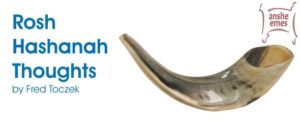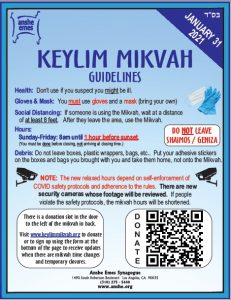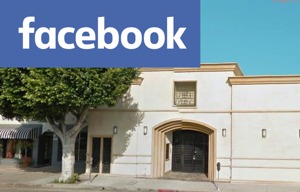ROSH HASHANAH: SELECTED THOUGHTS
Rosh Hashanah is observed on the first and second days of Tishri. It is called Yom Hadin (Day of Judgment) and marks the beginning of the Ten Days of Teshuvah, which culminate in Yom Kippur. It is a solemn day, a time of self-examination, when we reflect on our past mistakes and deeply regret our offenses against God and the hurts that we have caused others.
A MULTI-FACETED DAY
A Day of Judgment. The Talmud (Rosh Hashonah 16b) teaches that three books are opened before G-d on Rosh Hashonah: one for the wholly virtuous, one for total evildoers, and one for those in-between. The first are inscribed and sealed in the Book of Life; the second are inscribed and sealed in the Book of Death; the fate of the third is held in the balance until Yom Kippur — if they repent and are found worthy, they are inscribed for life; if not and they are found unworthy, they are inscribed for death. Hilchot Teshuvah teaches that each of us should consider ourselves in the last category. That is, each of us should consider ourselves (and the entire world) as half-meritorious and half-guilty – one sin tips the scale of guilt for ourselves and for the entire world; one mitzvah tips the scale of merit for our ourselves and the entire world. Incidentally, how can Rosh Hashonah be both a Day of Judgment and Yom Tov (i.e., a day of celebration)? While we are being judged, we know that G-d does so with kindness and to give us life; thus, we celebrate.
A Day On Which God Tests Our Hearts. As we recite in the Rosh Hashonah liturgy, “give praise to the One Who tests hearts on the Day Of Judgment; to the One Who reveals the depths in judgment.” As the Siach Sarfei Kodesh teaches, deep inside the heart of every Jew – even the most estranged — there is a spark of Jewishness that remains pure and perfect; this spark is reawakened and invigorated on Rosh Hashonah.
A Day Of New Beginnings. Rosh Hashonah, which occurs at the beginning of the month of Tishri, has been a time of new beginnings throughout history. Among the new beginnings ushered in by Tishri are: (a) God created Adam on the first day of Tishri (R’ Eliezer); (b) the Patriarchs were born at Tishri; (c) God remembered Sarah, Rachel and Hannah, who had been childless; (d) Joseph was freed from prison, beginning his rise to power in Egypt; and (e) the process of redemption of our ancestors in Egypt began with the end of their bondage and harsh labor. The month of Tishri is also in the autumn, a time when the harvest of the previous year has been gathered in and we take stock in order to close the books.
A Day Of Personal Introspection. The knowledge that God sits in judgment of us on Rosh Hashonah, determining our collective and individual fortunes for the year to come, sobers us to do serious self-searching and reappraise our personal life. Proof of this is found in the details of the mitzvah of Shofar. This mitzvah does not prescribe an ensemble of instruments, but only one. It thus emphasizes that our orientation should be, first and foremost, on improving ourselves, and introducing sanctity into even the ordinary and commonplace of our daily lives. As Rabbi Samson Raphael Hirsch wrote, “first become a blessing to yourself so that you may be a blessing to others.” Additionally, the Shofar is symbolic of prayer/introspection in the purest form – during the entire year, we pray with our physical being (our throat, tongue, teeth and lips); on Rosh Hashonah, we pray with our spiritual essence (our breath).
MALCHUYOT; ZICHRONOT AND SHOFAROT
The Mussaf Shemonah Esrei (Amidah), contains three special sections which are devoted to the main themes of the day: (a) Malchuyot (God is King), in which we accept God as our sovereign King and Ruler of the entire universe; (b) Zichronot (God remembers and judges), in which we affirm our belief in Divine Providence, that all of our deeds are remembered by God and that we are rewarded or punished according to our actions (we also ask God to remember Abraham’s supreme self-sacrifice when he bound Isaac on the altar); and (c) Shofarot (the Shofar), in which we relive the Giving of the Torah on Mount Sinai which occurred amidst thunder and lightning and powerful blasts of the Shofar, and we anticipate the final redemption and coming of the Mashiach, (when “the Lord God will blow the Shofar”). Each of these three sections is composed of an introduction followed by ten scriptural verses that express the central idea of the section: three of these verses are from the Torah, three from the Writings, three from the Prophets, with the concluding verse again from the Torah. In the Chazzan’s repetition of the Amidah, the Shofar is blown at the end of each of the three sections.
THE SHOFAR SERVICE
R ’Saadiah Gaon enumerates ten symbolic meanings to the Shofar: (1) Rosh Hashanah marks the anniversary of the creation and beginning of God’s sovereignty over Creation. The Shofar coronates God as King; (2) The Shofar proclaims the Ten Days of Repentance; (3) At Mt. Sinai, the Jews shouted “we will do and [then] we will listen” when they accepted the Torah; at that time, the sound of the Shofar continually increased and was very great. The Shofar thus reminds us of our commitment to “do” and [then] “listen” in the service of G-d; (4) The Shofar reminds us of the Prophets’ admonitions and calls to repentance; (5) The Shofar reminds us to pray for the rebuilding of the Holy Temple; (6) The Shofar, a ram’s horn, reminds us of the Binding of Isaac, and of our obligation to sacrifice our lives in Sanctification of the Holy Name; (7) The Shofar inspires fear and trembling in our hearts; (8) The Shofar reminds us of the awesome Judgment Day of the future; (9) The Shofar reminds us of the long anticipated ingathering of the exiles and arouses an inner yearning in our hearts for that time; and (10) The Shofar reminds us of (and awakens our belief in and yearning for) the resurrection of the dead.
The Lubavitcher Rebbe, z’tl brings down a number of additional beautiful insights into the Shofar, including the following: (a) its sound is compared to that of a child crying out to his/her parent (and, in turn, to our crying out to G-d, our Father); (b) the use of an animal’s horn reminds us that even our most hardened “animal-like” instincts are included in the service of G-d; (c) although many ritual vessels can become “tameh” (ritually impure), the Shofar cannot — the Shofar is the device with which we express our innate connection with G-d; this connection can be neither severed or sullied; it remains intact and is always ready to be drawn upon; (d) the Shofar preferably has a bend in it, symbolizing our willingness to bend our will to that of G-d; and (e) the mitzvah of the Shofar is only fulfilled when it is blown with the intent of connecting to G-dliness; the same is true of all mitzvos – they are not simply tasks to be blindly carried out, but rather are spiritual tools to connect with G-d in a meaningful way.
APPLES & HONEY/ROUND CHALLAHS
The apple and honey represents our wishes for a sweet year for ourselves, our families and the entire Jewish people. They also symbolize the following: (a) on most fruit trees, the leaves appear first to provide a protective cover for the young fruit. The apple, however, appears before its leaves. We are like an apple because we are willing to live out our Jewish lives even if it seems to leave us unprotected; (b) a bee can inflict pain by its sting yet also produces delicious honey; life has the same duality of potential; and (c) it focuses on the duality of a “good” and “sweet” year. Everything that happens is for the good since it is part of Divine Will. Thus, even things that look “bad” in our eyes are actually “good”. So, we ask God that the year be “sweet” (in addition to “good”) because we know that everything will be for the good, but we also ask that it be a “revealed” good (i.e., one that tastes “sweet” to us).
Round Challahs are traditionally used on Rosh Hashonah. The round challahs are shaped like a crown, an allusion to the Rosh Hashonah prayer “And so, all shall ascribe the crown to You.” In addition, a circle has neither a beginning nor an end, making it a fit symbol for long life. (Toras Moshe)
TORAH/HAFTORAH READINGS
The First Day. The Torah reading begins with Sarah’s conception of Isaac and his ensuing birth. The Haftorah recounts how the childless Hannah was blessed with a son. According to the Talmud, both Sarah and Hannah conceived on Rosh Hashonah. These readings remind us of Hashem’s mercy, and that sincere prayer and repentance can bring about Divine compassion that overcomes all adversity.
The Second Day. The Torah reading recounts the Akeidas Yitzchak (binding of Isaac), which recalls the sacrifices Abraham and Isaac were ready to make for God, and the additional merit to us on this day of judgment. (It also describes Abraham’s substituting the ram for Isaac, which is one of the reasons we blow the Shofar). The Haftorah is from Jeremiah and ends with the famous verse “is Ephraim (Israel) My Dear Son or Delightful Child, that whenever I speak of him I should remember him? Therefore, My inner Self yearns for him, and I shall surely take pity on him, says the Lord.” God is, in effect, saying that after all of Ephraim’s sins he does not really deserve God’s compassion; yet, God was moved by his pleas and had mercy on him. It also contains God’s promise to Jeremiah that the Jewish people will be redeemed, and the very moving passage of Rachael weeping for her children’s salvation.
TASHLICH. Tashlich is recited on Rosh Hashonah after Minchah. Casting our “sins” into a body of water has several meanings: (a) it reminds us, the Rema teaches, of G-d’s separation of the land from the waters) and His awesome might; (b) it reminds us of Akeidas Yitzhak (the Binding of Issac) – as the Midrash teaches, when Avraham was on his way to offer Yitzchak as a sacrifice, the Satan tired to deter them by turning himself into a raging river to block their path. Not to be side-tracked, Abraham resolutely walked into the river; (c) in ancient times kings were crowned on a riverbank to signify that their kingdom should flow smoothly and continuously like a river. On Rosh Hashanah, when we proclaim Hashem as King, we acknowledge our dependency on His mercy at the water’s edge (Otzar Hatefilos); (d) the water of a stream never stands still. It flows continuously, moving forward from place to place. On Rosh Hashonah, we let go of our bad habits and transgressions, wash them off and let them flow away (Torah Ha’olah); (e) just as the waters of the river keep moving forward, so too should our fervent prayers of Rosh Hashonah carry forward through the entire year (Maharshak, Sefer Hachayim); and (f) the eyes of its habitants – the fish – are always open. We pray that Hashem guards and protects us with open eyes and mercy all throughout the year (Shelah, Rosh Hashonah).
ROSH HASHONAH REFLECTIONS:
Pruning Our Garden. A prince built a tree-house in his father’s orchard. He failed to care for the tree and allowed vines and thorn branches to grow around it. Soon, it was impossible to approach the tree. Fortunately, the royal gardener inspected the orchard once a year and repaired all damage. With his tools, he cleared the vines and branches and the tree was free to breathe and grow again. On Rosh Hashonah, G-d releases each of us from “prison” and renews our lives. On this day, we too have the opportunity to free ourselves from our obstacles and renew our lives.
Realizing Our Potential. There is a famous story about an elderly sage named Reb Zusia. As he laid on his deathbed surrounded by his disciples and wept, they implored, “you were almost as wise as Moses himself”, “You were almost as kind as our father Abraham” and so on. Yet, Reb Zusia would not be comforted. “When I pass from this world and appear before the Heavenly tribunal, he said, “they won’t ask me, ‘why weren’t you as wise as Moses or as kind as Abraham;,’ rather they will ask me ‘why weren’t you Zusia!’ Why didn’t I fulfill my potential, why didn’t I follow the path that could have been mine.” On Rosh Hashonah, we confront our potential.
A Tzaddik Like Moshe. The Rambam (Hilcos Teshuvah) writes that “every person can be a tzaddik (righteous person) like Moshe”. HaGaon HaRav Elchonon Wasserman, zt’l asks “it is really possible for anyone to reach the level of Moshe?” R’ Wasserman explains that the Rambam is instructing us to, like Moshe, “use our entire being to sanctify Hashem”. Each of us can be a tzaddik “like” Moshe – each of us, according to our abilities, can serve Hashem to the utmost, as did the great Moshe.
The Power of a Ba’al Teshuvah. The Talmud (Berachos) teaches that where ba’alei teshuvah stand, even the completely righteous cannot reach. Why?
There once was a king who possessed three bottles of wine. All of them were rare vintage wine, an inheritance from his royal grandfather. When the king had to travel to a distant country, he called three of his closest and most beloved friends and entrusted each of them with one of the bottles. The king warned them not to drink the wine. Despite the warning, the first friend opened the bottle and drank its entire contents. The second friend refused to open the bottle. The third friend opened the wine and took a drink, then “came to his senses” and re-corked the bottle. When the king returned, the first friend was punished,, the second friend received 100 gold coins, and the third friend received 1,000 gold coins. The second friend protested – “why am I getting less than the guy who opened the bottle and took a sip?!,” he pleaded.. The king explained, “the third friend tasted the wine and experienced its allure, yet was able to strengthen his will-power and refrain from drinking the rest. His was the greatest act of love for me.”
The greatest love for Hashem is one who has tasted other ways of living and grown accustomed to them, yet is able to turn away from those temptations and serve Hashem.
Don’t Look Back. The Torah (Beresheis) writes “do not look behind you.” When approaching teshuvah, it is important to always look ahead.
Hope for Tomorrow. In Tehillim, we read “Hope to Hashem, strengthen yourself and He will give you courage; and hope to Hashem.” Why is “hope to Hashem” repeated a second time? The meforshim explain that sometimes we anticipate a positive event or change in our life, and it doesn’t materialize. We shouldn’t, however, be discouraged. On the contrary, we should present our request to Hashem again, with hope and energy.
The Essence of Time. “And Hashem said, let there be luminaries in the firmament, to divide between the day and the night and they shall be to signs, and to times and to days and to years. And they will be for luminaries in the heavens to light the world.” One would think that the main function of the luminaries is to light up the world, and that their timekeeping qualities would be secondary. Why, then, is the order reversed? The Torah is teaching us the vital importance of time, for a moment can never be restored. Particularly during these times, each moment is of endless potential.
A Mere Moment. In the Shemonah Esrei of this final Minchah of the year, we pray “Bless on our behalf – O Hashem, Our G-d – this year,” though all that is left of the year is just a few short minutes! This teaches us that every minute counts and reminds us that “Hashem’s help comes in the blink of an eye.” Even in the last minute of the year, His salvation can come in an instant. R’ Shalom of Belz, the Sar Shalom.
Never Far. “There is none other than Him.” R’ Elezer Menachem Shach explains this verse to mean that however far we may be from our Creator, we are still very close to Him.” Our closeness cannot be extinguished.
Step-By-Step. There once was a poor woman who had no money to feed her children. One day she managed to acquire an egg. “Dear children,” she exclaimed, “let’s not eat this egg! If we wait a while, the egg will hatch and we will have a chick. The chick will grow into a chicken that lays eggs every day. They will also hatch, and soon we’ll have a flock of chickens. We’ll sell the chickens and buy a little calf. The calf will grow into a cow and will give birth to many calves that will grow into cows. Before long we’ll have a big ranch with a large herd of cattle. Listen, dear children, this little egg will make us rich!” In her excitement, the mother held up the egg for her children to see. It slipped out of her hand – and cracked wide open on the kitchen floor. During this time, we often made lofty albeit worthwhile resolutions. But, as soon as the Days of Awe pass, we go back to our old ways, and the good intentions evaporate. The challenge is to ensure that our resolutions are rooted in the present, and at a level at which we can actually make day-to-day progress. (Darchei No’am)




 Visit the group and request to join.
Visit the group and request to join.

B”H Thank you so much for the beautiful devrei Torah. My computer printed out these 3 pages and ble neder I will share some of these ‘thoughts’ with my family.
Yasher Koach. Shana tova Ktiva ve’Chatima Tova Channah Rachel Herrmann
This is truly beautiful and meaningful. Thanks for posting. Ktiva vchatima tovah umetukah